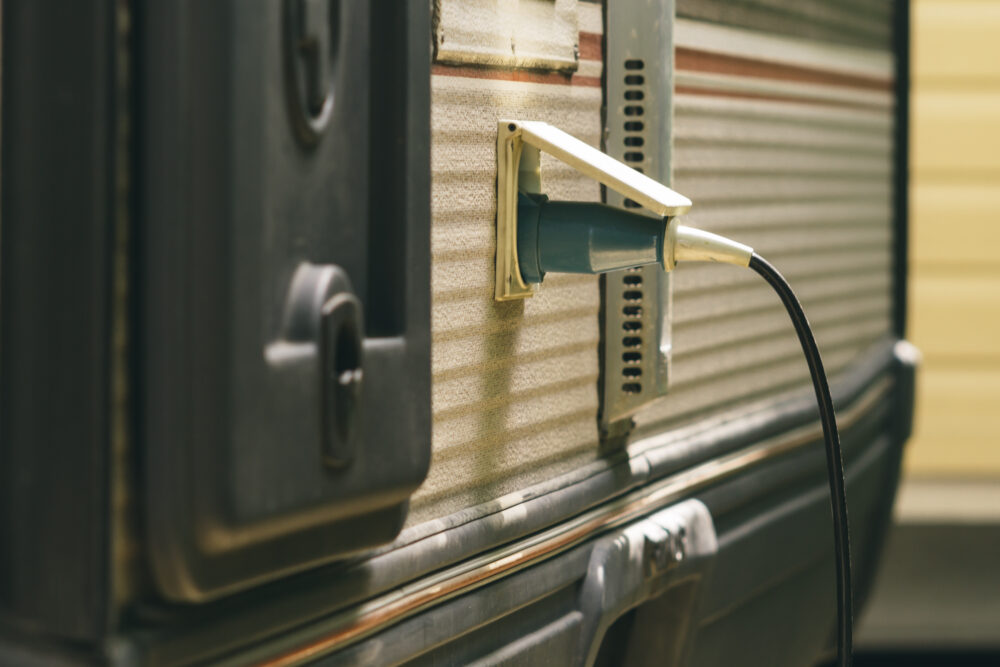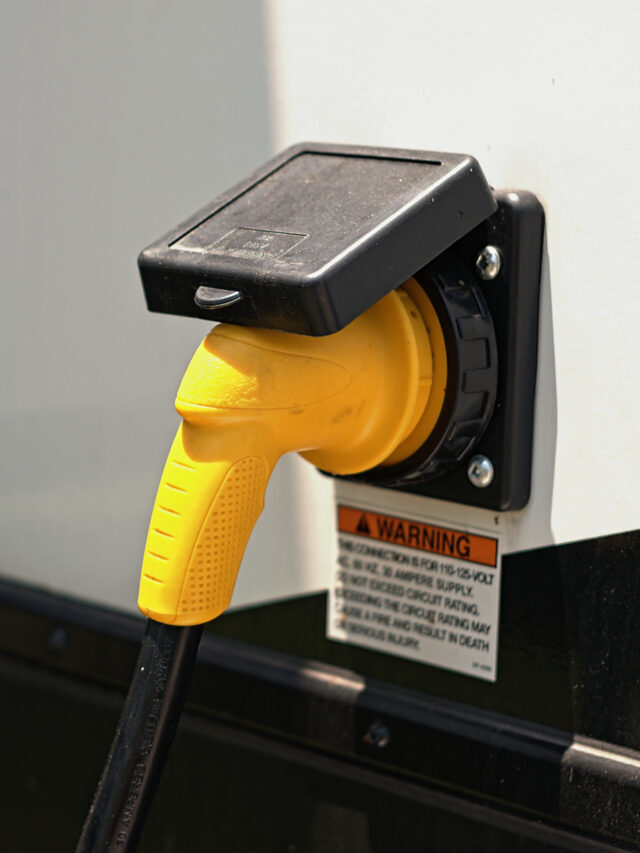
10 Important Electrical Safety Tips For RVers
One of the best parts about RVs is that they have electricity. That means we can run a refrigerator, use our electric coffee pot, watch TV, and enjoy many other comforts of home while we camp.
Electricity is essential to RVing. After all, electricity keeps almost everything in the RV functioning. Even the RV water system depends on an electric pump.
As much as electricity allows us to enjoy the comforts of home, the RV electrical system is quite different from a home electrical system. Your RV has both an AC power system and a DC power system. Each of these systems are set up to run smoothly and meet the electrical needs of the RV. However, RV electrical systems demand the same respect as a home electrical system or maybe even more.
Here are 10 electrical safety tips you need to know when you’re RVing. First, let’s have a look at hot skin (also called stray voltage).
What Is RV Hot Skin?
Before we do anything else, let’s talk about RV hot skin. Every year, RV hot skin kills a lot of unsuspecting RVers. So, if you RV, you need to know what it is and how to avoid it.
RV hot skin (also known as stray voltage) is when the RV’s electrical current becomes diverted to the frame, chassis, or metal parts outside the RV.
RV users may get a shock entering or exiting the RV, and in all too common circumstances, the shock can be lethal. If your RV is shocking you (even mildly), it’s important to disconnect the RV from its power source and find out what is causing the hot skin. Don’t connect again until you deal with whatever is causing the hot skin.
Hot skin can be caused by:
- Reverse polarity or bad wiring at the power source
- Improper wiring
- Improper grounding
- Loose or damaged connections
- Using a 20-amp extension cord instead of a 30-amp or 50-amp extension cable
- A damaged cord set
You can safely test your RV for hot skin by using a non-contact voltage tester. Simply hold the voltage tester within a few inches of the frame of your RV. If it turns red and beeps, you have a hot skin problem. If your RV has hot skin, you’ll need to unplug and figure out what is causing it.
Using an EMS or surge protector is the best defense against RV hot skin. An EMS/surge protector provides a barrier by monitoring electricity for problems. The EMS/surge protector will immediately shut off power if there is any problem that could cause hot skin.
1. Check that the pedestal breaker is set to “off” before you plug in or unplug
Before you plug in, make sure the breaker on the pedestal is set to “off”. If it’s on when you plug in and there is something wrong with the electricity, you could damage your plug, surge protector, or your RV’s electrical system. Turning the breaker off before you unplug saves wear and tear on both the outlet and your RV’s electrical system.
2. Never trust a power pedestal to be properly wired and maintained
Before you plug your RV or surge protector in, give the pedestal outlets a quick visual inspection. If the outlets look worn, or the wiring looks burned, don’t take a chance by plugging your RV in at that pedestal.
Even if things look good, test the circuit using a multimeter. Here is how to do that:
- Set your multimeter to 600 VAC.
- With the breaker switch set to “on”, insert one probe of the multimeter into the part of the outlet that holds the ground and the other probe into the left (hot) side of the outlet. This will give you the voltage reading for the outlet. It should be around 120-124v for 30-amps.
- Next, insert one probe into the ground part of the outlet and one probe into the neutral side of the outlet. This should give you a reading of 0. If it is anything but 0, the outlet was wired wrong and has reverse polarity. Don’t plug into the outlet.
- For 50 amps, the hot legs are parallel to one another. Test each hot leg, as in the instructions for the 30-amp outlet. The readings should be between 110v and 120v. Then test the two hot legs, putting one probe in each of them. This should give you a multimeter reading of about 240V.
3. Take good care of your RV electrical cords
Your RV electrical cord and extension cable need to be in good shape to do their jobs properly and not turn into an RV electrical safety hazard. Here are a few things you can do so it will last for years and stay in good condition:
- Protect your RV electrical cord and extension cable in a storage bag when not in use.
- Don’t leave your RV electrical cord or RV extension cable out in the sun, rain, or snow.
- Inspect the plug, outlet, and housing for corrosion, wear, and damage or splits in the housing before each use.
- Inspect your adapters for wear and tear regularly too.
Corroded plugs, damaged outlets, and worn or split cord casing can cause RV hot skin. When hot skin happens, the frame, chassis, and body of the RV conduct electricity and may shock anyone who touches the RV.
4. Never plug in with a 20-amp extension cord
We’ve all been there. You’re moochdocking in a driveway, but the nearest electrical outlet is 50 feet away. While you might be able to power a few things in the RV with an ordinary 20-amp extension cord, you should never use one to plug your RV in to shore power.
Your RV’s electrical system was designed to run in perfect balance with an adequate supply of electricity. If you try to run power through a 20-amp extension cord instead of a 30-amp or 50-amp cord, you won’t get adequate flow of electrons to your RV, and you could wreck your electrical system. This is another situation that can cause hot skin.
5. Test your RV for hot skin using a non-contact voltage tester
You can easily test your RV for hot skin using a non-contact voltage tester. A non-contact voltage tester looks like a pen and is a quick and easy way to check your RV for hot skin.
6. Electrical plugs and adapters should always have a ground pin
The ground pin is there to protect you in the event of an electrical problem by diverting electrical current to the ground, so it doesn’t go to you or the frame of your RV. Using plugs and adapters without ground pins gets people killed every year. Don’t become one of them!
7. Avoid repeatedly resetting breaker switches
Tripped breaker switches are telling you something. Continually resetting them wears them out. Instead, if you have a breaker switch that is continually tripping, find out what the cause is.
It’s often because too much power is being drawn, and you’ll need to shut something off. Otherwise, there could be a short somewhere that the breaker is providing protection from.
8. Avoid overloading RV electrical outlets and circuits
RV electrical safety rules are the same as the rules we have at home. One of these rules is to avoid overloading electrical outlets and circuits.
Overloading an AC outlet with a space heater or another high-wattage appliance can cause plugs and wiring to overheat and start a fire.
Each appliance draws a certain number of watts of electricity. The total number of watts that can be used is limited by the number of amps of power the RV is plugged into.
To avoid overloading the RV electrical system, the electrical load should not exceed 85% of the total number of watts available at the 20-amp, 30-amp, or 50-amp outlet. To simplify this, here is how many watts you can safely run at 20, 30, and 50 amps:
- 20 amps: 1850- 2000 watts
- 30 amps: 2800-3000 watts
- 50 amps: 4900-5100 watts
Now you can add up the watts of the appliances you want to run. You’ll find a label on the back of most plug-in appliances to tell you the watts or volts they use. If you don’t have the label, you can always search online or use the Amps x Volts = Watts formula. For example:
An RV plugged into a 20-amp, 110-volt household outlet could run:
- LED TV 28 watts
- RV fridge 450 watts
- Hot water heater 450 watts
- RV microwave 800 watts
If the RV owner wanted to run an Instant Pot (1000 watts), they would have to turn off one of the other AC appliances to avoid overloading the circuit and tripping a breaker switch.
9. twist lock your RV cord plug and tighten the locking ring
Loose electrical connections are always an electrical safety hazard. A loose plug connection can cause an RV hot skin situation. Be sure to twist and lock your cord set connector in place with the locking ring.
10. Always use a surge protector
Using a good surge protector will not only protect your RV’s electronics from damage in the event of a voltage surge, but it could also save your life if you happen to hook up to a bad power supply.
Track your RV maintenance
Make sure you keep track of all your RV maintenance and repairs with an online tool such as RV LIFE Maintenance. Not only can you keep all of your documents in one place, but you’ll also receive timely reminders when maintenance is due to help you avoid costly repairs and potentially serious accidents.
Related articles:




